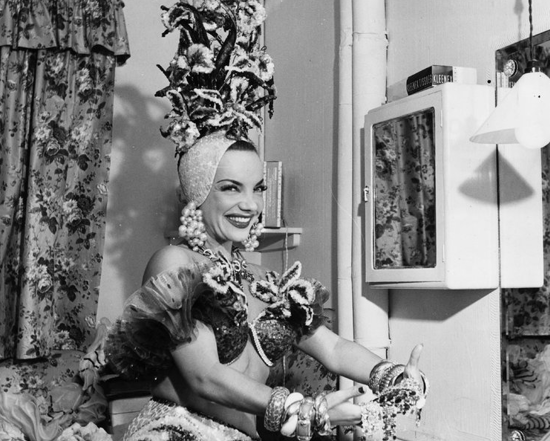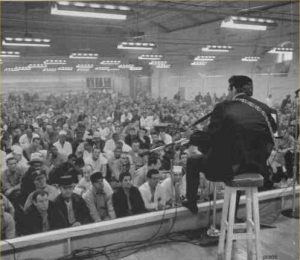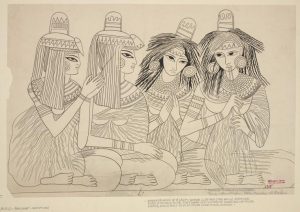Does the name Carmen Miranda sound familiar? What about “the lady in the tutti-frutti hat?” If not, do not feel ashamed, for many have forgotten the excellent Brazilian performer. No Brazilian artist, however, has achieved the international recognition that Carmen Miranda has, especially in Latin America and the States. She was one of the highest-paid women in Hollywood during the 1940’s.1 Yet she is today something of an unknown figure. Why is that?

Well, it dates back to the day she was born. Carmen Miranda was born Maria do Carmo Miranda da Cunha in a village in Portugal on February 9, 1909. She migrated to Brazil with her family in 1910, before turning two years old.2 Though she remained a Portuguese citizen, she was at home in Rio de Janeiro, Brazil. She began performing at a very early age, winning over her family and friends with her talent, and soon she had become a samba sensation. She was cutting records and was a star nearly a whole decade before coming to the United States. One night in 1939, while performing at the famous Cassino da Urca (in a neighborhood in Rio de Janeiro), New York producer Lee Shubert signed her for his show The Streets of Paris on Broadway, and away she went to take the world by surprise.3 While on Broadway, she enchanted everyone with her vibrant singing, dancing, and “Brazilian bombshell” beauty.
At 38 years old she married; however, given the huge persona she was, it is strange that there is not much known about her personal life. The extent of it is that she was raised Catholic, and this may be the reason she married at a mature age. It was rumored that she and her husband, David Sebastian, had a troubled marriage.
It was 1940 when she returned from Broadway to her homeland Brazil, but she was devastated by the way she was received. At the same Casino where Shubert had snatched her from less than a year earlier, Miranda performed to a crowd in awkward silence; only when she began to sing in English did the crowd make some noise, booing. She stopped the show and was so upset that she burst into tears. This incident sent her fleeing from the country, and for about fifteen years she did not return.4
Meanwhile, Miranda spent her time on Broadway and in Hollywood, Las Vegas, and London starring in movies, performing in casinos and clubs, expanding her fame and reputation. She was the tropical beauty from Brazil and there was no one to change her mind about it. Yes, she was a European woman with pale skin and green eyes, but these features are what made her unique, and people found it interesting that a woman like her sang black music. Her unique style gave her the recognition she has acquired as an iconic Latin American. Carmen Miranda was well-known for her outrageously colorful costumes, which called for high platform heels, lots of jewelry, flamboyant dresses, and most famously the turbans with fake fruit stacked so high that it added height to her short stature of 5’0’’. 5 “In Brazil in Bahia, the girls carry the basket with the fruits on her head, and they have big bracelets and big necklaces and they sell fruits in the streets and I take it [my style] from the girls,” Miranda explained as the source of her image.6

For years people have attacked Carmen Miranda on racial grounds. Critics say she had returned to Brazil americanizada. In response, she wrote a song in their mother tongue—the only country in Latin America to speak Portuguese—whose title translates to “They Say I Came Back Americanized.”7 It was also said that she was a sellout and was not truly a native, having been born in Portugal. Some say she was simply portraying the “Brazilian Bombshell” image and embodied the typical stereotype the U.S. public wanted to see in Brazilians, and Latin Americans more generally, where women are highly sexualized. Others argued that her style had created a distorted view of the country, as being sexually exposed, extravagantly colorful, and fruity. They argued that the turbans she wore were not even Brazilian customs and were only used to make fun of her.8 She was even mocked on a Bugs Bunny cartoon. To make matters worse, some said she had no right to sing samba, a music inherited in Brazilian black slums.

On the contrary, Carmen Miranda put Rio de Janeiro on the map of spectacular. She was the most successful person Brazil had produced. In a way, she served as an unofficial ambassador for her country, and it is heavily reflected in her movie roles.9 Everything that was Latin American was a hybrid presented in her performances, her style, her songs, friends and fans. She was everything, and nothing at once: Brazilian, Mexican, Argentinian, Cuban. Hollywood productions during this time period would touch on different cultures, but never fully embrace one, and this may have been what happened to Miranda. She became involved in Franklin D. Roosevelt’s Good Neighbor Policy, which was a program determined to improve relations with the nations of Central and South America.10 She still is the only South American to be immortalized in concrete at Sid Grauman’s Chinese Theatre, “To Sid, VIVA! in the South American Way. Carmen Miranda. March 24th 1941,” neighboring none other than Frank Sinatra. 11 Rio’s Museum of Modern Art welcomed Carmen Miranda with a major retrospective; “Carmen Miranda Forever,” where clips from her movies were shown, and gowns and turbans were showcased. She even had a museum in Rio dedicated to her, the Carmen Miranda Museum. Here, there was a wide variety of arrangements, gowns, costumes, shoes, and anything you can think of that she had performed in. The building itself was not lavish and fabulous as she was. Therefore it did not suit the gems hidden inside. Due to lack of maintenance and funds, it was closed down. It was agreed that Miranda deserved better.12 On the bright side, the museum is being relocated to Rio de Janeiro Museum of Image and Sound, expecting to open anytime soon. 13

It is a difficult task to relate to Carmen Miranda’s plight. She took many chances in leaving Brazil: that of being lost in translation, the crossing of geographical and cultural borders, sounding like herself in a different language, being in a sustained condition of exile. One person could not possibly represent an entire continent, especially one as diverse as that of Latin America with its many rich cultures. Today, it is not rare to be a Brazilian in the United States, in contrast to the way it once was. With that in mind, there is no Brazilian artist that has coped with these issues on the scale that Miranda had to in her prime. A director for a play on Carmen Miranda’s life said it better than anyone: “Carmen hasn’t been forgotten, but she’s been kind of ignored or neglected in recent years.”14 There are people today who have become interested in her, that have opened their minds to who she really was and why she has become an obsolete figure. They will learn that she was a charming, charismatic, comical, and extravagant person, a figure to inspire.15
- Larry Rohter, “Arts Abroad: The Real Carmen Miranda Under the Crown of Fruit,” New York Times, Dec. 13, 2001. Accessed April 13, 2017, http://www.nytimes.com/2001/12/13/theater/arts-abroad-the-real-carmen-miranda-under-the-crown-of-fruit.html. ↵
- Encyclopedia of Latin American History and Culture, 2008, s.v. “Miranda, Carmen (1909-1955),” by John Cohassey. ↵
- Larry Rohter, “Arts Abroad; The Real Carmen Miranda Under the Crown of Fruit,” New York Times, Dec. 13, 2001. Accessed April 13, 2017, http://www.nytimes.com/2001/12/13/theater/arts-abroad-the-real-carmen-miranda-under-the-crown-of-fruit.html. ↵
- Larry Rohter, “Arts Abroad; The Real Carmen Miranda Under the Crown of Fruit,” New York Times, Dec. 13, 2001. Accessed April 13, 2017, http://www.nytimes.com/2001/12/13/theater/arts-abroad-the-real-carmen-miranda-under-the-crown-of-fruit.html. ↵
- Maria Rubia Macedo, “Images of Latin America In the Body and Costumes of Carmen Miranda’s Stylized Baiana: Social Memory and Identity,” Comunicação e Sociedade 24, (2013): 186-209. ↵
- Lulu Garcia-Navarro, “Of Fruit Hats and ‘Happy Tropics,’ A Renaissance for Carmen Miranda,” NPR Parallels, April 22, 2015. Accessed April 13, 2017, http://www.npr.org/sections/parallels/2015/04/22/401467980/of-fruit-hats-and-happy-tropics-a-renaissance-for-carmen-miranda. ↵
- Lulu Garcia-Navarro, “Of Fruit Hats and ‘Happy Tropics,’ A Renaissance for Carmen Miranda,” NPR Parallels, April 22, 2015. Accessed April 13, 2017, http://www.npr.org/sections/parallels/2015/04/22/401467980/of-fruit-hats-and-happy-tropics-a-renaissance-for-carmen-miranda. ↵
- Larry Rohter, “Arts Abroad; The Real Carmen Miranda Under the Crown of Fruit,” New York Times, Dec. 13, 2001. Accessed April 13, 2017, http://www.nytimes.com/2001/12/13/theater/arts-abroad-the-real-carmen-miranda-under-the-crown-of-fruit.html. ↵
- Lulu Garcia-Navarro, “Of Fruit Hats and ‘Happy Tropics,’ A Renaissance for Carmen Miranda,” NPR Parallels, April 22, 2015. Accessed April 13, 2017, http://www.npr.org/sections/parallels/2015/04/22/401467980/of-fruit-hats-and-happy-tropics-a-renaissance-for-carmen-miranda. ↵
- “Good Neighbor Policy,” Office of the Historian, April 13, 2017, https://history.state.gov/milestones/1921-1936/good-neighbor. ↵
- Ralph Morris, “Carmen Miranda, Grauman’s Chinese Theater,” Los Angeles Public Library Photo Collection, Accessed April 13, 2017, https://calisphere.org/item/d381f8bd9fd414dd5661ab0aeeffa4a7/. ↵
- Mac Margnolis, “We Still Have Bananas,” Newsweek (Atlantic Edition) 147, no. 4 (January 23, 2006): 55. ↵
- Lulu Garcia-Navarro, “Of Fruit Hats and ‘Happy Tropics,’ A Renaissance for Carmen Miranda,” NPR Parallels. April 22, 2015. April 13, 2017. http://www.npr.org/sections/parallels/2015/04/22/401467980/of-fruit-hats-and-happy-tropics-a-renaissance-for-carmen-miranda. ↵
- Larry Rohter, “Arts Abroad; The Real Carmen Miranda Under the Crown of Fruit,” New York Times, Dec. 13, 2001. Accessed April 13, 2017, http://www.nytimes.com/2001/12/13/theater/arts-abroad-the-real-carmen-miranda-under-the-crown-of-fruit.html. ↵
- Film clip “Carmen Miranda: ‘Rebola a Bola’ (1941),” from Week-End in Havana, film directed by Walter Lang, 20th Century Fox, 1941. Music by Aloysio de Oliveira and Nestor Amaral, lyrics by Francisco Eugenio Brant Horta, sung in Portuguese by Carmen Miranda. ↵



83 comments
Anayetzin Chavez Ochoa
She seems like a fun person to have been around! It’s a shame she wasn’t so well received back at home. I always wondered where that costume originated, as it has been associated with Brazil for a long time, and I couldn’t put my finger on it. Many foreign actors have found more success in America than in their home countries, which baffles me for some reason. Thank you for writing this!
Eugenio Gonzalez
The article’s compelling narrative maintains the reader’s attention with Carmen Miranda’s ups and down in her career and personal life. It is interesting to find the origin of the fruit baskets’ turbans. I like how the last paragraphs explain why Carmen Miranda has been ignored over the years. Unfortunately, Carmen Miranda has been neglected over the years for her accomplishments, but articles like this help preserve the image of Carmen Miranda.
Melyna Martinez
This article really shows how Carmen Miranda was perceived in the US and how different she was perceived in Brazil. Making a name for her culture and where she came from gave her the opportunity to move a lot of Brazilians did not like that. With that, her fame did come with a lot of controversy and hate, but it does not stray away from the light she brings to her culture and country.
Sofia Perez
Amazing article Gabriela! I have seen people dress up like her, but I did not know she was the one that started the trend. Many were intrigued that a woman like her sang black music because of her distinctive looks, which were Brazilian. She is known as an iconic Latin American because of her distinctive fashion sense. After hearing about all her allegations, I felt really made for people making fun of and mocking her.
Hailey Koch
I really loved reading your article you did a fantastic job. Before your article, I wasn’t familiar with Carmen Miranda and I absolutely loved how you told her story. Miranda was a Brazilian performer that was also known as “the lady in the tutti-frutti hat”. The saddest part is even though she was this amazing well-known performer of her time now she is barely known. It’s sad to see how influential she was at her time and how over all of this time I am one of the many who doesn’t know of her existence. I believe your article is something that will show people her greatness and get her name known again.
Victorianna Mejia
This was such a wonderful article! I had no idea who Carmen Miranda was prior to this reading. I wonder if this is because of how she was portrayed during her time by Brazilians. I wish she would have had more support from her country. As I read this, I felt like she was proud of them, but the feelings were not reciprocated, which is truly heartbreaking.
Andrea Ramirez
Very interesting article. I had not previously heard of this, at that time recognized, artist. I found the way she became famous intriguing, and I think it was quite unique and for that she became a Latin American icon.
By reading the article, I can see how Carmen had her difficult moments of criticizing in order to carry out her, finally, successful career.
I found it fascinating that this artist represented several Latin American countries without sticking to just one.
Finally, I want to mention that the order in which you reported the events made your article quite clear and understandable. Also, you made a very good choice with the images.
Nice job!
Aurora Torres
Great Article! I have heard of Carmen Miranda but only by images and some clips of her dancing. But never knew about who she really was, but reading your article helped to understand a bit about her. She was daring woman who fought to be who she was and did no care what anyone said about her, she was very talented Latin American woman with many talents. Interesting to read that not so much is known about her life. While reading also, it was sad that her homeland in Brazil booed her for her performance and left not returning after 15 years. However she made her life in the U.S and continued to prosper with her dancing and singing and her movie roles and being highly paid as one of the top Latin American woman. I believe that she went through so much to get where she was at and she did what she enjoyed doing til the very end. Thanks again for the great article.
Claire Saldana
This was a very good article. I had never heard of Carmen but her story was very upsetting. I hate how they treated her especially since she came to the US for new opportunities and she did well. I’m glad that she used it to grow but she also didn’t change who she was or what she did. In fact, she showed that she was more than a dancer she worked to better political relations between her country and the US.
Andrew Ponce
This article finds a person who was nearly forgotten in history, and brings her back to life with detailed wording of her life and what her life meant to different groups of people. It was interesting to see how a person can inspire so much love and hate at the same time, while being in Hollywood. Great article!